This book aims to assist information and health professionals and educators with all phases of information provision and support, from understanding users’ information needs, to building relationships, to helping users verify and evaluate sources. The book can be used as a textbook in library and information science programs, as well as nursing, communication, journalism, psychology, and informatics programs.
The book, written from the e-health literacy perspective, is unique in its nuanced approach to misinformation. It draws on psychology and information science to explain human susceptibility to misinformation and discusses ways to engage with the public deeply and meaningfully, fostering trust and raising health and information literacy.
It is organized into three parts.
Part I: The Ecology of Online Health Information' overviews the digital health information universe, showing that misinformation is prevalent, dangerous, and difficult to define.
Part II: Susceptibility to Misinformation: Literacies as Safeguards addresses factors and competencies that affect individual vulnerability and resilience.
Part III: Solutions focuses on education and community engagement initiatives that help the public locate and evaluate health information.
Chapters within the three Parts discuss technological innovation and social media as posing novel risks as well as presenting novel solutions to helping the public connect with high quality information and building trusting relationships among the public and information and health professionals.
This book aims to assist information and health professionals and educators with all phases of information provision and support, from understanding users’ information needs, to building relationships, to helping users verify and evaluate sources. The book can be used as a textbook in library and information science programs, as well as nursing, communication, journalism, psychology, and informatics programs.
The book, written from the e-health literacy perspective, is unique in its nuanced approach to misinformation. It draws on psychology and information science to explain human susceptibility to misinformation and discusses ways to engage with the public deeply and meaningfully, fostering trust and raising health and information literacy.
It is organized into three parts.
Part I: The Ecology of Online Health Information' overviews the digital health information universe, showing that misinformation is prevalent, dangerous, and difficult to define.
Part II: Susceptibility to Misinformation: Literacies as Safeguards addresses factors and competencies that affect individual vulnerability and resilience.
Part III: Solutions focuses on education and community engagement initiatives that help the public locate and evaluate health information.
Chapters within the three Parts discuss technological innovation and social media as posing novel risks as well as presenting novel solutions to helping the public connect with high quality information and building trusting relationships among the public and information and health professionals.

Combating Online Health Misinformation: A Professional's Guide to Helping the Public
246
Combating Online Health Misinformation: A Professional's Guide to Helping the Public
246
Product Details
| ISBN-13: | 9781538162200 |
|---|---|
| Publisher: | Bloomsbury Academic |
| Publication date: | 09/10/2022 |
| Series: | Medical Library Association Books Series |
| Pages: | 246 |
| Product dimensions: | 7.00(w) x 10.00(h) x 0.52(d) |
